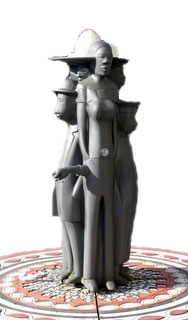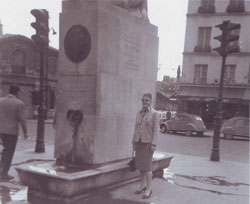Water in Paris, Part 6: Tidbits
Continuing our series of articles on water in Paris here we present a list of odds and ends or tidbits about and around water in Paris.
- The motto of Paris « Fluctuat nec mergitur » is closely linked to the Seine. It is a Latin phrase which means Tossed by the waves, but never sinks. In French Il est battu par les flots, mais ne sombre pas. The motto dates from antiquity and was used, along with a ship, on the arms of the corporation des Nautes (the water merchants).
- The first recorded flood of Paris was in 585.
- The original bateaux-mouches dating from the 19th century were named for Mouche, a section of the city of Lyon where they were built.
- Bathhouses were first created along the Seine in 1688. The first warm baths were available in 1761 and in 1785 the first swimming area was created along with the first swimming school in the world.
- The quays of the Seine are a UNESCO World Heritage site from pont de Sully to pont d’Iéna.
- 200,000 years ago the Seine was three kilometers wide.
- 460487m³ of potable water is distributed in Paris each day.
- The Poterne des Peupliers in the 13th arrondissment is an opening in the Thiers ramparts of 1840 in the 13th arrondissement. A poterne is a passage way through the ramparts in this case it allowed the River Bièvre to flow into Paris and provide water in case of siege. Today the Bièvre is underground and traffic flows through the poterne.
- How did the Samaritain department store get its name? From a water pump that was on Pont Neuf! The pump was constructed on the second arch of the bridge by the orders of king Henri IV in 1608. On the façade of the pump there was a relief sculpture of Christ and the good samaritain. The pump brought water to the Louvre palace and nearby public fountains. It was demolished in 1813 but the name remains.
- Streets:
- There is a rue des Eaux in the 16th arrondissement. The street was created in 1650. During construction the builders discovered a mineral water spring. The spring ceased to exist at the end of the 18th century but you will find the Musée du Vin on this street.
- Rue du Bac was named for the ferry that crossed the river at this location bringing blocks of stone to build the Tuileries Palace in 1564.
- Passage des Eaux Vives is in the 11th arrondissement. The name comes from a basin from which water flows. The street exists since 1974. Interestingly many local businesses offer sanitary products and services.
- Rue de la Bonne near Montmartre also is a « water street ». The name Bonne is all that is left of the former appellations of Bonnes Eaux or Bonne Fontaine. There was indeed a water fountain on this street as well.
- And let us not forget rues de la Duée (in the 16th century a spring was called a duée), des Cascades and impasse des Rigaunes which means rigoles or rivulets. Rue de Seine and Bièvre (dating from 1250) are of course named for the rivers.
- Also Rues du Puits-de-l’Ermite, de l’Aqueduc, du Ruisseau, de l’Abreuvoir (called ruelle qui va au but in 1325 this street lead to the fountain of the village Montmartre) or de la Mare and Villa du Lavoir in the 10th.
- Eau de Paris is more than just a water company. They offer all kinds of outings to visit the water sites and sights around Paris. There are bike trips, boat trips, visits to aqueducts and subterranean reservoirs. Check out the schedule here
-
The most recent fountains in Paris are called les poings d’eau – a play on words from point d’eau where one uses the wrist (poing) of the people on the fountain to turn the water on. They are located along the Tramway T3b and are the work of Camerounian artist Pascale Marthine Tayou.
- According to the Pavillion de l’eau the main water pollutants are: Natural pollutants, Hydrocarbons, Sunscreen lotions, Organic matter, Bacteria and Viruses.
- The first visit of the Paris sewers was organized in 1867 as part of the Universal Exhibition. Tours were made first by wagon, then in row boats and since 1972 on foot.
- In 1902 four Newfoundland dogs joined the police force’s river brigade. Their names were Turc, César, Medge and Paris. The dog brigade lasted only until 1907. Read more.
This article is part of a series on Water in Paris. Revisit for future installments.
- Part 1: La Seine
- Part 2: Drinking water
- Part 3: Non-Drinking water
- Part 4: Crossing the Seine
- Part 5: Paris Canals
- Part 6: Tidbits
- Part 7 : Speak Easy, idomatic expressions using water
- Part 8: Paris flood 2016



